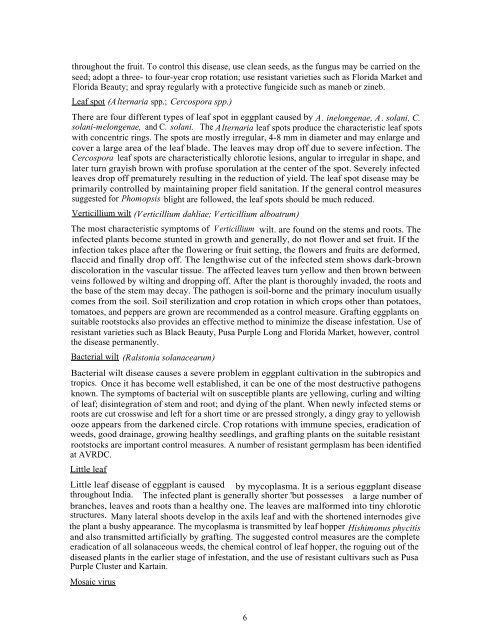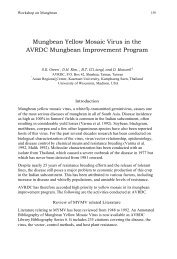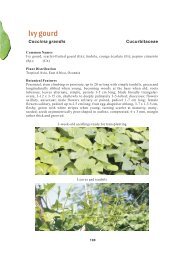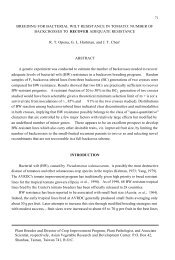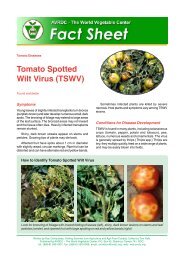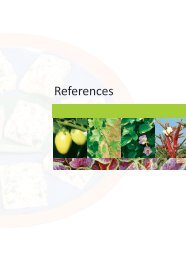CULTIVATION AND SEED PRODUCTION OF EGGPLANT NC Chen
CULTIVATION AND SEED PRODUCTION OF EGGPLANT NC Chen
CULTIVATION AND SEED PRODUCTION OF EGGPLANT NC Chen
Create successful ePaper yourself
Turn your PDF publications into a flip-book with our unique Google optimized e-Paper software.
throughout the fruit. To control this disease, use clean seeds, as the fungus may be carried on the<br />
seed; adopt a three- to four-year crop rotation; use resistant varieties such as Florida Market and<br />
Florida Beauty; and spray regularly with a protective fungicide such as maneb or zineb.<br />
Leaf spot (Alternaria spp.; Cercospora spp.)<br />
There are four different types of leaf spot in eggplant caused by A. inelongenae, A. solani, C.<br />
solani-melongenae, and C. solani. The Alternaria leaf spots produce the characteristic leaf spots<br />
with concentric rings. The spots are mostly irregular, 4-8 mm in diameter and may enlarge and<br />
cover a large area of the leaf blade. The leaves may drop off due to severe infection. The<br />
Cercospora leaf spots are characteristically chlorotic lesions, angular to irregular in shape, and<br />
later turn grayish brown with profuse sporulation at the center of the spot. Severely infected<br />
leaves drop off prematurely resulting in the reduction of yield. The leaf spot disease may be<br />
primarily controlled by maintaining proper field sanitation. If the general control measures<br />
suggested for Phomopsis blight are followed, the leaf spots should be much reduced.<br />
Verticillium wilt (Verticillium dahliae; Verticillium alboatrum)<br />
The most characteristic symptoms of Verticillium wilt. are found on the stems and roots. The<br />
infected plants become stunted in growth and generally, do not flower and set fruit. If the<br />
infection takes place after the flowering or fruit setting, the flowers and fruits are deformed,<br />
flaccid and finally drop off. The lengthwise cut of the infected stem shows dark-brown<br />
discoloration in the vascular tissue. The affected leaves turn yellow and then brown between<br />
veins followed by wilting and dropping off. After the plant is thoroughly invaded, the roots and<br />
the base of the stem may decay. The pathogen is soil-borne and the primary inoculum usually<br />
comes from the soil. Soil sterilization and crop rotation in which crops other than potatoes,<br />
tomatoes, and peppers are grown are recommended as a control measure. Grafting eggplants on<br />
suitable rootstocks also provides an effective method to minimize the disease infestation. Use of<br />
resistant varieties such as Black Beauty, Pusa Purple Long and Florida Market, however, control<br />
the disease permanently.<br />
Bacterial wilt (Ralstonia solanacearum)<br />
Bacterial wilt disease causes a severe problem in eggplant cultivation in the subtropics and<br />
tropics. Once it has become well established, it can be one of the most destructive pathogens<br />
known. The symptoms of bacterial wilt on susceptible plants are yellowing, curling and wilting<br />
of leaf; disintegration of stem and root; and dying of the plant. When newly infected stems or<br />
roots are cut crosswise and left for a short time or are pressed strongly, a dingy gray to yellowish<br />
ooze appears from the darkened circle. Crop rotations with immune species, eradication of<br />
weeds, good drainage, growing healthy seedlings, and grafting plants on the suitable resistant<br />
rootstocks are important control measures. A number of resistant germplasm has been identified<br />
at AVRDC.<br />
Little leaf<br />
Little leaf disease of eggplant is caused by mycoplasma. It is a serious eggplant disease<br />
throughout India. The infected plant is generally shorter 'but possesses a large number of<br />
branches, leaves and roots than a healthy one. The leaves are malformed into tiny chlorotic<br />
structures. Many lateral shoots develop in the axils leaf and with the shortened internodes give<br />
the plant a bushy appearance. The mycoplasma is transmitted by leaf hopper Hishimonus phycitis<br />
and also transmitted artificially by grafting. The suggested control measures are the complete<br />
eradication of all solanaceous weeds, the chemical control of leaf hopper, the roguing out of the<br />
diseased plants in the earlier stage of infestation, and the use of resistant cultivars such as Pusa<br />
Purple Cluster and Kartain.<br />
Mosaic virus<br />
6


